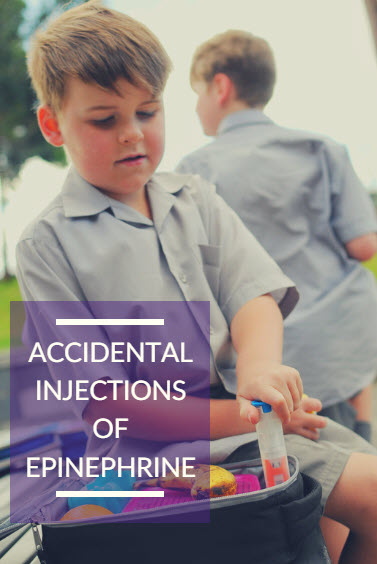 Self-administrated shots of epinephrine (often referred to by the brand name EpiPen or epinephrine pen) are life-saving devices which can halt an allergic reaction and give a patient time to get to a hospital. For children and adults who experience anaphylaxis, an epinephrine shot is a matter of life or death. But it’s important for patients and caregivers to know how to properly work an automatic epinephrine shot. An incorrect or accidental administration can have dangerous consequences.
Self-administrated shots of epinephrine (often referred to by the brand name EpiPen or epinephrine pen) are life-saving devices which can halt an allergic reaction and give a patient time to get to a hospital. For children and adults who experience anaphylaxis, an epinephrine shot is a matter of life or death. But it’s important for patients and caregivers to know how to properly work an automatic epinephrine shot. An incorrect or accidental administration can have dangerous consequences.
Accidental Epinephrine Injections & the Consequences:
In order for epinephrine to work properly, it must be injected into the thigh muscle. The greatest risk of an accidental or an incorrect injection is that injecting the epinephrine elsewhere can delay or impair the effectiveness during a time-critical emergency.
Aside from this, there are also risks of an accidental injection in and of itself. An accidental intravenous injection (which is very rare and would be fairly difficult to do on accident), is especially dangerous and can lead to hypertension and/or heart problems[1]. Most accidental injections (an estimated 94%) occur when a patient or someone trying to help them accidentally jabs their finger or thumb[2]. An accidental injection to the hands or feet can impair blood flow to these areas and can potentially cause tissue death. This however, is the worst-case scenario.
Symptoms of an accidental injection are not usually so severe and may include:
- temporary numbness or tingling
- pain and swelling at the injection site
- elevated heart rate and/or heart palpations.
Regardless, you should always seek medical attention in the event of an accidental injection; it’s better safe than sorry!
Know How To Use an Epinephrine Auto-injector:

It never hurts to refresh your memory on how to use your child’s epinephrine shot. You may even want to print out the instructions and keep them in a handy place (for example, fold it up and keep it with the epinephrine shot). EpiPen has several resources to teach patients about the proper use of epinephrine shots.
For best results, ask your child’s healthcare team to demonstrate how to properly use an epinephrine shot[3]. Research shows that parents who receive hands-on training are better able to properly demonstrate how to use their child’s epinephrine shot[4]. Remind them to be careful!
An ironic side note: An estimated 10% of accidental epinephrine injections occur when healthcare providers demonstrate how to use the injector to their patients!
How many of you carry epinephrine auto-injectors for your children? Have you ever had to deal with an accidental epinephrine injection?
If you are looking for additional tips on epinephrine at school, we have several additional blog posts you might enjoy:
-Mallory






